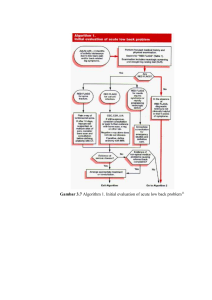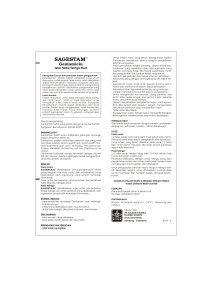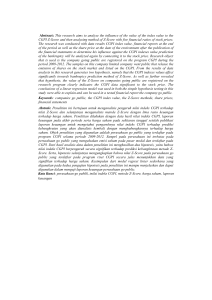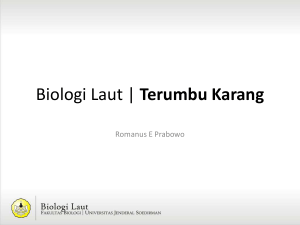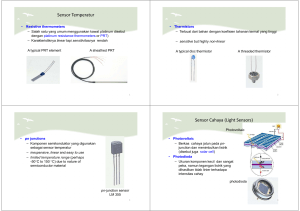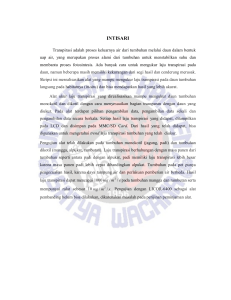Image Formation - Nana - Politeknik Elektronika Negeri Surabaya
advertisement
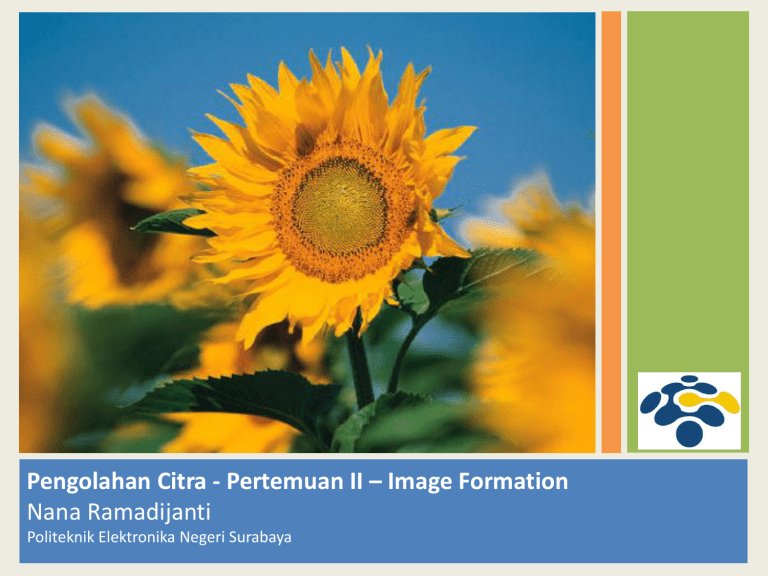
Pengolahan Citra - Pertemuan II – Image Formation Nana Ramadijanti Politeknik Elektronika Negeri Surabaya Materi: 1. 2. 3. 4. 5. 6. 7. 8. 9. 10. 11. Pengertian Kamera Aperture,DOF,Zoom Visual Perception Human Eye Kamera Digital Kamera CCD Kamera CMOS Sampling Kuantisasi Tipe gambar Format gambar Model Sederhana dari Pembentukan Gambar • Gambar diterangi oleh sumber • Gambar mencerminkan radiasi ke arah kamera. • Kamera mendeteksi melalui bahan kimia (film) atau sel-sel solid state (kamera CCD) Dua Bagian Dari Proses Pembentukan Citra (Image Formation) 1. Pembentukan Citra secara Geometri adalah pembentukan citra yang menentukan di mana proyeksi piksel pada gambar akan ditempatkan di bidang gambar 2. Pembentukan Citra secara Fisika Cahaya adalah menentukan kecerahan suatu piksel pada bidang gambar sebagai fungsi penerangan dan sifat permukaan Model Sederhana : f(x,y) = i(x,y) r(x,y) i: illumination, r: reflectance Disain Kamera • Tempatkan film di depan sebuah obyek • Apakah kita akan mendapatkan gambar yang wajar ? – Blurring – Perlu lebih selektif! Disain Kamera (lanjutan) • Tambahkan penghalang dengan lubang kecil (yaitu aperture) untuk memblokir sebagian besar sinar – Mengurangi blurring Model Kamera “Pinhole” • Perangkat sederhana untuk membentuk sebuah gambar 3D pada permukaan 2D. • Sinar cahaya melewati “pinhole" dan membentuk sebuah gambar obyek yg terbalik pada bidang gambar perspective projection: center of projection (x,y) (X,Y,Z) fX x Z fY y Z f: focal length Apa pengaruh dari ukuran aperture? Aperture Besar: cahaya dari sumber menyebar di seluruh gambar (tidak terfokus dengan benar), membuatnya kabur ! Aperture kecil: mengurangi blurring tetapi (i) membatasi jumlah cahaya yang masuk kamera dan (ii) menyebabkan difraksi cahaya. Contoh: Berbagai ukuran aperture Contoh: Berbagai ukuran aperture (lanjutan) • Apa yang terjadi jika kita terus menurun ukuran aperture? • Ketika cahaya melewati lubang kecil, tidak bepergian dalam garis lurus dan tersebar di berbagai arah (difraksi) Solusi : refraksi Refraksi • Melenturkan gelombang ketika memasuki medium di mana kecepatan berbeda. Lensa • Lensa meniru geometri pinhole tanpa menggunakan aperture kecil yang tidak diinginkan. – Mengumpulkan semua cahaya memancar dari titik objek terhadap aperture lensa yang terbatas. – Membawa cahaya menjadi fokus pada titik gambar ideal. refraction Lensa(lanjutan) • Lensa meningkatkan kualitas gambar, yang mengarah ke gambar yang lebih tajam. Sifat “thin” lens (Lensa Ideal) focal point f • Sinar cahaya melewati pusat tidak menyimpang. • Sinar cahaya melewati titik yang jauh dari pusat menyimpang lebih banyak.. Sifat “thin” lens (Lensa Ideal) focal point f • Semua sinar paralel konvergen ke satu titik. • Ketika sinar tegak lurus terhadap lensa, hal itu disebut titik fokus. Properties of “thin” lens focal point f • • Bidang sejajar dengan lensa pada titik fokus disebut bidang fokus. (focal plane). Jarak antara lensa dan bidang fokus disebut panjang fokus (yaitu, f =focal length)lensa. Depth of Field Ukuran seberapa jauh bidang fokus/ ketajaman dalam gambar. http://www.cambridgeincolour.com/tutorials/depth-of-field.htm Bagaimana kita bisa mengontrol Depth of Field? • Ukuran lingkaran blur sebanding dengan ukuran aperture. Bagaimana kita bisa mengontrol Depth of Field? (lanjutan) • Mengubah ukuran aperture (dikontrol oleh diagfragma) mempengaruhi depth of field. – Aperture yang lebih kecil meningkatkan rentang di mana objek di sekitar fokus (tetapi perlu meningkatkan exposure time). – Aperture yang lebih besar mengurangi DOF (tetapi perlu mengurangi exposure time) Berbagai Ukuran Aperture Aperture Besar = DOF Kecil Aperture Kecil = DOF Besar Bidang Pandang (Zoom) • Kerucut arah pandang kamera. • Berbanding terbalik dengan panjang fokus. f f Bidang Pandang (Zoom) Mengurangi Distorsi Perspective dengan Memvariasikan Jarak / Focal Length Small f (i.e., large FOV), camera close to car Large f (i.e., small FOV), camera far from car Less perspective distortion! Efek Yang Sama Pada Wajah Less perspective distortion! standard wide-angle telephoto Penting: Kita dapat mendekati proyeksi perspektif menggunakan model sederhana bila menggunakan lensa tele untuk melihat jauh objek yang memiliki kisaran DOF yang kecil. Pendekatan kamera “affine” Pusat proyeksi berada di tak hingga ! Lensa Nyata • All but the simplest cameras contain lenses which are actually comprised of several "lens elements." • Each element aims to direct the path of light rays such that they recreate the image as accurately as possible on the digital sensor. Hukum Lensa : Chromatic Aberration • Lensa memiliki indeks bias yang berbeda untuk panjang gelombang yang berbeda • Dapat menyebabkan warna fringing (biasanya terlihat pada tepi kontras tinggi dalam gambar) : – misalkan lensa tidak dapat fokus pada semua warna pada satu titik yang sama Contoh : Chromatic Aberration Human Eye • Fungsinya menyerupai kamera : aperture (adalah:pupil), lens, mekanisme untuk fokus (zoom in/out) dan permukaan untuk mendaftarkan gambar (adalah:retina) Human Eye (lanjutan) • Pada kamera, fokus pada bermacam jarak dicapai dengan bermacam-macam jarak diantara lensa dan bidang gambar • Pada human eye, jarak diantara lensa dan retina tetap (misal: 14mm sampai 17mm). Human Eye (lanjutan) • Fokus dicapai dengan bermacam-macam bentuk lensa (misal: merata penebalan). Human Eye (lanjutan) • Retina contains light sensitive cells that convert light energy into electrical impulses that travel through nerves to the brain. • Brain interprets the electrical signals to form images. Human Eye (Lanjutan) • Two kinds of light-sensitive cells: rods and cone (unevenly distributed). • Cones (6 – 7 million) are responsible for all color vision and are present throughout the retina, but are concentrated toward the center of the field of vision at the back of the retina. • Fovea – special area – Mostly cones. – Detail, color sensitivity, and resolution are highest. Human Eye(lanjutan) • Three different types of cones; each type has a special pigment that is sensitive to wavelengths of light in a certain range: – Short (S) corresponds to blue – Medium (M) corresponds to green – Long (L) corresponds to red . – approx. 10:5:1 • Almost no S cones in the center of the fovea RELATIVE ABSORBANCE (%) • Ratio of L to M to S cones: 440 530 560 nm. 100 S M L 50 400 450 500 550 WAVELENGTH (nm.) 600 650 Human Eye (lanjutan) • Rods (120 million) more sensitive to light than cones but cannot discern color. – Primary receptors for night vision and detecting motion. – Large amount of light overwhelms them, and they take a long time to “reset” and adapt to the dark again. – Once fully adapted to darkness, the rods are 10,000 times more sensitive to light than the cones Intensity Brightness Adaptation of Human Eye : Mach Band Effect Position Mach Band Effect Intensities of surrounding points effect perceived brightness at each point. In this image, edges between bars appear brighter on the right side and darker on the left side. (Images from Rafael C. Gonzalez and Richard E. Wood, Digital Image Processing, 2nd Edition. Mach Band Effect (Cont) A Intensity B Position In area A, brightness perceived is darker while in area B is brighter. This phenomenon is called Mach Band Effect. Brightness Adaptation of Human Eye : Simultaneous Contrast Simultaneous contrast. All small squares have exactly the same intensity but they appear progressively darker as background becomes lighter. Simultaneous Contrast (Images from Rafael C. Gonzalez and Richard E. Wood, Digital Image Processing, 2nd Edition. Optical illusion (Images from Rafael C. Gonzalez and Richard E. Wood, Digital Image Processing, 2nd Edition. Visible Spectrum (Images from Rafael C. Gonzalez and Richard E. Wood, Digital Image Processing, 2nd Edition. Digital cameras • A digital camera replaces film with a sensor array. – Each cell in the array is lightsensitive diode that converts photons to electrons – Two common types • Charge Coupled Device (CCD) • Complementary metal oxide semiconductor (CMOS) http://electronics.howstuffworks.com/digital-camera.htm Digital cameras (cont’d) Image Sensors : Array Sensor Charge-Coupled Device (CCD) w Used for convert a continuous image into a digital image w Contains an array of light sensors w Converts photon into electric charges accumulated in each sensor unit CCD KAF-3200E from Kodak. (2184 x 1472 pixels, Pixel size 6.8 microns2) CCD Cameras • CCDs move photogenerated charge from pixel to pixel and convert it to voltage at an output node. • An analog-to-digital converter (ADC) then turns each pixel's value into a digital value. http://www.dalsa.com/shared/content/pdfs/CCD_vs_CMOS_Litwiller_2005.pdf CMOS Cameras • • • CMOs convert charge to voltage inside each element. Uses several transistors at each pixel to amplify and move the charge using more traditional wires. The CMOS signal is digital, so it needs no ADC. http://www.dalsa.com/shared/content/pdfs/CCD_vs_CMOS_Litwiller_2005.pdf Image digitization • Sampling: measure the value of an image at a finite number of points. • Quantization: represent measured value (i.e., voltage) at the sampled point by an integer. Image digitization (cont’d) Sampling Quantization What is an image? 8 bits/pixel 0 255 What is an image? (cont’d) • We can think of a (grayscale) image as a function, f, from R2 to R (or a 2D signal): – f (x,y) gives the intensity at position (x,y) f (x, y) x y – A digital image is a discrete (sampled, quantized) version of this function Effect of Spatial Resolution 256x256 pixels 128x128 pixels 64x64 pixels 32x32 pixels Effect of Spatial Resolution (Images from Rafael C. Gonzalez and Richard E. Wood, Digital Image Processing, 2nd Edition. Moire Pattern Effect : Special Case of Sampling Moire patterns occur when frequencies of two superimposed periodic patterns are close to each other. (Images from Rafael C. Gonzalez and Richard E. Wood, Digital Image Processing, 2nd Edition. Effect of Spatial Resolution (Images from Rafael C. Gonzalez and Richard E. Wood, Digital Image Processing, 2nd Edition. Can we increase spatial resolution by interpolation ? Down sampling is an irreversible process. (Images from Rafael C. Gonzalez and Richard E. Wood, Digital Image Processing, 2nd Edition. Image Quantization Image quantization: discretize continuous pixel values into discrete numbers Color resolution/ color depth/ levels: - No. of colors or gray levels or - No. of bits representing each pixel value - No. of colors or gray levels Nc is given by Nc 2 where b = no. of bits b Quantization function Quantization level Nc-1 Nc-2 2 1 0 Light intensity Darkest Brightest Effect of Quantization Levels 256 levels 128 levels 64 levels 32 levels Effect of Quantization Levels (cont.) 16 levels 8 levels 4 levels 2 levels In this image, it is easy to see false contour. How to select the suitable size and pixel depth of images The word “suitable” is subjective: depending on “subject”. Low detail image Lena image Medium detail image High detail image Cameraman image To satisfy human mind 1. For images of the same size, the low detail image may need more pixel depth. 2. As an image size increase, fewer gray levels may be needed. (Images from Rafael C. Gonzalez and Richard E. Wood, Digital Image Processing, 2nd Edition. Human vision: Spatial Frequency vs Contrast Human vision: Distinguish ability for Difference in brightness Regions with 5% brightness difference Digital Image Types : Intensity Image Intensity image or monochrome image each pixel corresponds to light intensity normally represented in gray scale (gray level). Gray scale values 10 10 16 28 9 6 26 37 15 25 13 22 32 15 87 39 Digital Image Types : RGB Image Color image or RGB image: each pixel contains a vector representing red, green and blue components. RGB components 10 10 16 28 56 43 9 656 70 26 3756 78 70 32 99 54 96 67 15 256013 902296 67 21 54 47 42 32 15 87 39 85 85 43 92 54 65 65 39 32 65 87 99 Image Types : Binary Image Binary image or black and white image Each pixel contains one bit : 1 represent white 0 represents black Binary data 0 0 1 1 0 0 1 1 0 0 1 1 0 0 1 1 Image Types : Index Image Index image Each pixel contains index number pointing to a color in a color table Color Table Index No. 1 4 9 6 4 7 6 5 2 Index value … Red Green Blue component component component 1 0.1 0.5 0.3 2 1.0 0.0 0.0 3 0.0 1.0 0.0 4 0.5 0.5 0.5 5 0.2 0.8 0.9 … … … Image file formats • Many image formats adhere to the simple model shown below (line by line, no breaks between lines). • The header contains at least the width and height of the image. • Most headers begin with a signature or “magic number” (i.e., a short sequence of bytes for identifying the file format) Common image file formats • • • • • • GIF (Graphic Interchange Format) PNG (Portable Network Graphics) JPEG (Joint Photographic Experts Group) TIFF (Tagged Image File Format) PGM (Portable Gray Map) FITS (Flexible Image Transport System) PBM/PGM/PPM format • A popular format for grayscale images (8 bits/pixel) • Closely-related formats are: – PBM (Portable Bitmap), for binary images (1 bit/pixel) – PPM (Portable Pixelmap), for color images (24 bits/pixel) ASCII or binary (raw) storage » ASCI Binary
